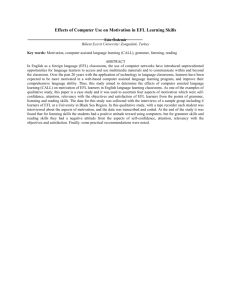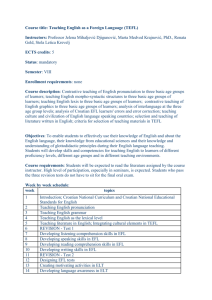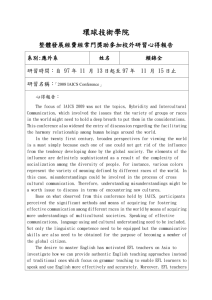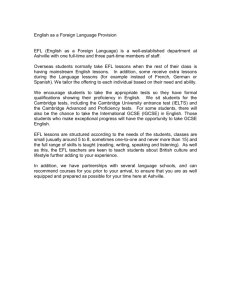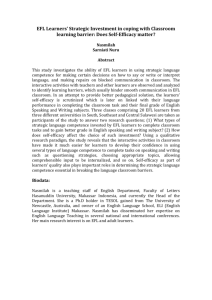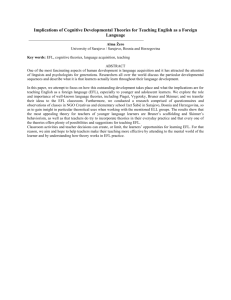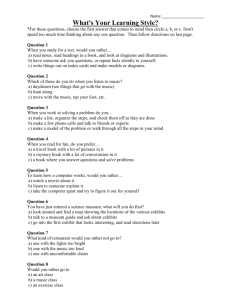The Effect of Game Tic Tac Toe and Flash Cards on Zero Beginners
advertisement
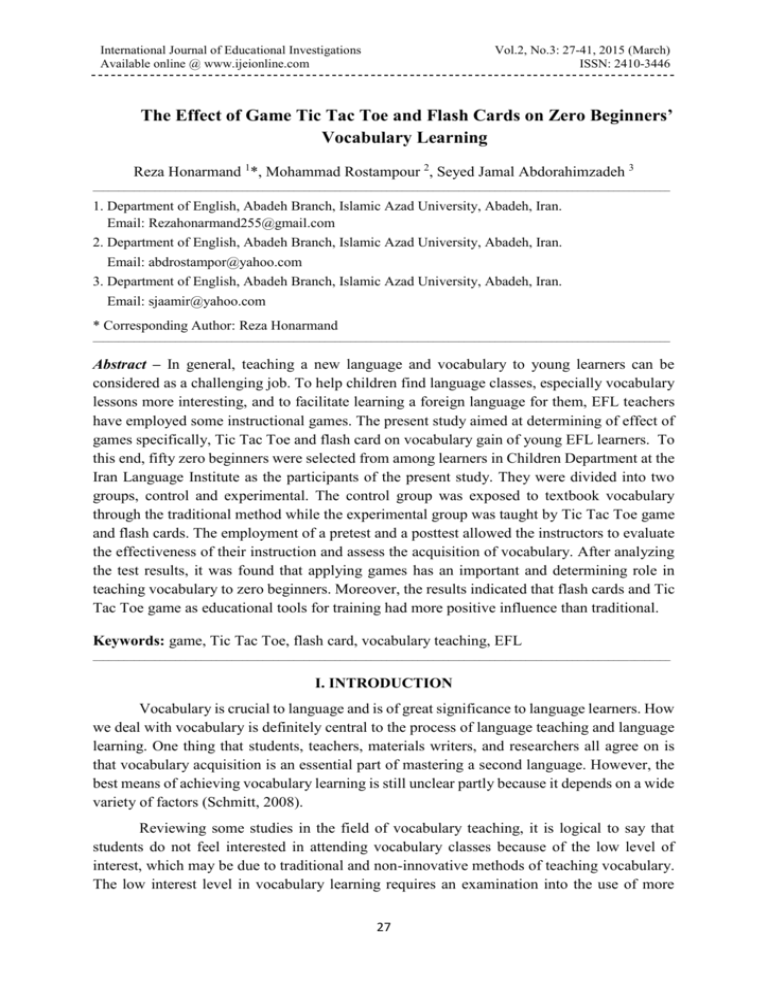
International Journal of Educational Investigations Available online @ www.ijeionline.com Vol.2, No.3: 27-41, 2015 (March) ISSN: 2410-3446 The Effect of Game Tic Tac Toe and Flash Cards on Zero Beginners’ Vocabulary Learning Reza Honarmand 1*, Mohammad Rostampour 2, Seyed Jamal Abdorahimzadeh 3 ________________________________________________________________________________________________________________ 1. Department of English, Abadeh Branch, Islamic Azad University, Abadeh, Iran. Email: Rezahonarmand255@gmail.com 2. Department of English, Abadeh Branch, Islamic Azad University, Abadeh, Iran. Email: abdrostampor@yahoo.com 3. Department of English, Abadeh Branch, Islamic Azad University, Abadeh, Iran. Email: sjaamir@yahoo.com * Corresponding Author: Reza Honarmand ________________________________________________________________________________________________________________ Abstract – In general, teaching a new language and vocabulary to young learners can be considered as a challenging job. To help children find language classes, especially vocabulary lessons more interesting, and to facilitate learning a foreign language for them, EFL teachers have employed some instructional games. The present study aimed at determining of effect of games specifically, Tic Tac Toe and flash card on vocabulary gain of young EFL learners. To this end, fifty zero beginners were selected from among learners in Children Department at the Iran Language Institute as the participants of the present study. They were divided into two groups, control and experimental. The control group was exposed to textbook vocabulary through the traditional method while the experimental group was taught by Tic Tac Toe game and flash cards. The employment of a pretest and a posttest allowed the instructors to evaluate the effectiveness of their instruction and assess the acquisition of vocabulary. After analyzing the test results, it was found that applying games has an important and determining role in teaching vocabulary to zero beginners. Moreover, the results indicated that flash cards and Tic Tac Toe game as educational tools for training had more positive influence than traditional. Keywords: game, Tic Tac Toe, flash card, vocabulary teaching, EFL ________________________________________________________________________________________________________________ I. INTRODUCTION Vocabulary is crucial to language and is of great significance to language learners. How we deal with vocabulary is definitely central to the process of language teaching and language learning. One thing that students, teachers, materials writers, and researchers all agree on is that vocabulary acquisition is an essential part of mastering a second language. However, the best means of achieving vocabulary learning is still unclear partly because it depends on a wide variety of factors (Schmitt, 2008). Reviewing some studies in the field of vocabulary teaching, it is logical to say that students do not feel interested in attending vocabulary classes because of the low level of interest, which may be due to traditional and non-innovative methods of teaching vocabulary. The low interest level in vocabulary learning requires an examination into the use of more 27 R. Honarmand et al. interactive methods of teaching vocabulary, such as the use of games. So in order to make the instruction of vocabulary interesting and involve the students in the process of learning vocabulary in an un-imposed manner, an action research was conducted using games to teach vocabulary. The use of games for vocabulary teaching and its wash-back effect is well documented in various studies. Games help many students to shed their embarrassment and be able to participate more actively in the meaning making process. According to Celce-Murcia (1989) “games are fun and nearly every one would agree that if learning can be made enjoyable for students, their student will learn more” (p. 53). Also, Huang (2007) stated that games can help shy students to shed their inhibitions and come up to the center of the classroom. Vocabulary development is a nonstop process where learners meet the words many times in their learning to increase and deepen their knowledge and their use of words in the foreign language (Cameron, 2001). Word memorization is also facilitated through using meaningful activities to practice vocabulary as it provides learners with opportunities to memorize words effectively, which means that this cannot be achieved successfully if they just practice them orally by drilling or by using flashcards. Activities which involve learners in thinking about words and making decisions about them allow learners to remember words effectively. The importance of learning vocabulary cannot be stressed enough for any student at any stage of educational growth. In the background of proven research about the importance of vocabulary development, it becomes imperative that the teaching of vocabulary be debated and the techniques used for it be evaluated from time to time. Judd (1978) stated that vocabulary teaching has been transferred to secondary status in favor of syntax. However, it is argued that vocabulary development should be treated as a skill which is independent and complementary to reading and writing skills. Language skill development should include a selection for teaching of vocabulary as a separate skill as it is ‘one of the major aspects of fluency in a language’ (ibid). Hence vocabulary should be taught as a separate skill in all stages of education. Even though the importance of teaching vocabulary is a determined field of study, its transfer in a language classroom fails to incorporate the students’ interest in the teaching practice. A. Statement of the Problem In learning a foreign language, vocabulary is one of the basic parameters. It is an element that links the four skills of speaking, listening, reading and writing all together. In order to communicate well in a foreign language, students should acquire an adequate number of words and should know how to use them accurately. Teaching and learning second language vocabulary has far been underrated in the field of second language acquisition (SLA) for zero beginners in our country, Iran. However, it seems that in the last two decades, a recurrence of interest has been observed in areas such as vocabulary learning and teaching. 28 R. Honarmand et al. Dealing with the problem of how to motivate EFL learners for vocabulary learning has led to some cases of research on games. For example, Huang (2007) investigated the question whether learning through games could improve students' motivation. Hansen (1994) noted “Games are highly motivating and entertaining, and they can give shy learners more opportunity to express their opinions and feelings.” (p.118). If the goal of learning strategies is to develop learners’ motivational or affective state, or the way in which students select, organize, acquire, or integrate new knowledge (Chamot & O’Malley, 1990), then by providing them with the tools to self-regulate their own learning, students will be able to develop autonomy (Skehan & Dörnyei, 2002). By exerting control over their own learning operations, learners will be able to manage their own productions, and this, as a result, will enhance their learning capabilities. B. Objectives of the Study Given the importance of vocabulary learning in language teaching, the purpose of the present study was to assess the impact of games (Tic Tac Toe and flash cards) on zero beginners vocabulary learning. Since at the early stages of language learning, learners need more help in developing their lexical boundaries, language teachers' help is crucial in this way they can protect their learners' motivation. Games have been found to be useful and effective pedagogical tools that should be employed in vocabulary classes, so this research intended to study the retention of vocabulary learning among EFL zero beginners using Tic Tac Toe and flash cards. C. Significance of the Study Teaching through the application of games makes the teaching/learning process enjoyable, alive, visible, attractive, and motivating. Definitely, early stages of an additional language acquisition for young learners have a fundamental effect on later stages. In spite of the significant role of vocabulary acquisition in second and foreign language learning, it has always been a mind boggling concern of EFL learners. The primary focus of this study is to present solutions to overcome the difficulties young EFL learners have in acquiring new lexical items by investigating which part of speech they acquire faster and easier. It also attempts to examine the effect of using flash cards and Tic Tac Toe for developing the vocabulary learning on zero beginners vocabulary learning. This study may provide EFL teachers with a specific language teaching procedure which they can use in their classroom to enhance their students’ achievement in English vocabulary learning. The findings of this study can be helpful for EFL teachers, learners and decision-makers. 29 R. Honarmand et al. D. Research Questions The present research aims at finding the effect of two kinds of games on EFL learners' incidental vocabulary learning. More specifically the researchers have attempted to investigate the following research questions. Q1. Does Tic Tac Toe game have any effect on EFL zero beginners vocabulary learning? Q2. Do flash cards have any effect on EFL zero beginners vocabulary learning? E. Research Hypotheses Based on the aforementioned research questions the following hypotheses will be formulated: 1. Tic Tac Toe game does not have any effect on EFL zero beginners incidental vocabulary learning. 2. Flash cards do not have any effect on EFL zero beginners incidental vocabulary learning. II. LITERATURE REVIEW Vocabulary learning is one of the great challenges that foreign language learners face during the process of learning a language. Many researchers claim that vocabulary is an essential part of language learning, and the importance of vocabulary in the EFL learning process has been widely recognized and well-established, and a number of specific strategies for learning vocabulary have been identified by many researchers (Ahmed, 1998; Nakamura, 2000; Oxford, 1990; Schmitt, 2008). Some experts have figured out with a large enough vocabulary the students can comprehend and speak a great deal of foreign language (Terrell, 1986). Also, DeCarrico (2001) found that students realize the importance of vocabulary when learning language in other words, they have focused on the role of vocabulary learning in achieving educational objectives in various fields. Teachers have been trying to give opportunities to students to make them more motivated when performing vocabulary learning activities. So in recent years, there have been a lot of studies on vocabulary learning techniques. For example, using games have been employed as an effective tool in English language learning as a second language. There is now general agreement among vocabulary specialists that lexical competence is at the very heart of communicative competence, the ability to communicate successfully and appropriately (Coady & Huckin, 1997). It is advocated that learning the precise vocabulary can be considered more important than learning part of grammar as the key factor for learning a language. Therefore, teachers should have a good strategy to be able teach vocabulary to their students. Teachers’ skill is the important factor among others to achieve the teaching goal. Teaching through game is one technique to motivate students in learning English: it is very important especially in refreshing, and amusing students in learning so they will not make students bored while they are studying English. Nation (1995) categorized vocabulary into two main groups: general service vocabulary (frequently used words) and special-purpose 30 R. Honarmand et al. vocabulary (words for academic purposes). She believed that this classification is important because different types of words require different instructional processes. Celce-Murcia (1991) introduces three stages in teaching planned vocabulary: conveying meaning (stage one), checking for comprehension (stage two), and consolidation (stage three). Rivers (1981) has recommended some different points which the students need to acquire in order to learn vocabulary (p. 289). These points are summarized as follows: 1. To commit vocabulary to long-term memory. 2. To discriminate variations in distribution and new boundary of meaning. 3. To detect morpheme which recur in number of words. 4. To penetrate camouflages that cognate or borrowed words have adopted in becoming assimilated within another language. 5. To discover new words for themselves. 6. To know the elastic quality of vocabulary. The significance of vocabulary acquisition in learning another language is illustrated by Wilkins (1972) as “Without grammar, little can be conveyed, without vocabulary, nothing can be conveyed” (p. 111). DeCarrico (2001) claims that “vocabulary learning is central to first and second language acquisition and specialists now emphasize the need for a systematic and principled approach to vocabulary by both teachers and learners” (p. 285). In the process of learning language use of vocabulary knowledge is in relation to types of vocabulary learning. Four types of vocabulary learning have been discussed by the researchers including: incidental, intentional, implicit, and explicit (Horst, Cobb, and Meara, 1998; Laufer and Hulstijn, 2001). The use of the terms incidental and intentional learning in the psychological literature goes back to the beginning of the twentieth century and has been used in experimental psychology for a long time. Incidental learning is the process of learning something without the intention of doing so. Wright, Betteridge and Buckby (1984) stated that "learning through games could encourage the operation of certain psychological and intellectual factors which could facilitate communication heightened self-esteem, motivation and spontaneity, reinforcing learning, improving intonation and building confidence"(p.451).Teachers can use games to develop their language learning motivation. Uberman (1998) affirms the helpful role of games in vocabulary teaching after quoting and analyzing different opinions of experts. She observed the enthusiasm of her students on learning through games in her classes. She considers games a way to help students not only enjoy and entertain with the language they learn, but also practice it incidentally. Games can lower anxiety, thus making the acquisition of input more likely (RichardAmato, 1988). Hornby (1995) believes that game is an activity that you do to have some fun. Games can make students focus on the game and learn the language unconsciously. They are 31 R. Honarmand et al. highly motivating and entertaining, and they can give shy students more opportunity to express their opinion and feelings (Hansen, 1994). With the use of games, the teacher can create various contexts in which students have to use the language to communicate, exchange information and express their own opinion (Wright et al., 1984). For example, tic-tac-toe is a classic and simple game that can make learning English fun. Make a board that contains nine squares, just like a classic tic-tac-toe board. You will also need flash cards. Use the flash cards like you usually do. When one person gets an answer right they get to put down an X or an O. Whoever gets three in a row first wins. III. METHODOLOGY A. Participants and Setting In total, 50 participants were chosen from a population of Iranian zero beginners male students who were studying at the children’s Department of the Iran Language Institute, Shiraz Branch, Boys’ Unit. They were attending English program for the first time, and they did not have any exposure to English. All the participants were native Persian speakers, and their age range was from seven to nine. As far as tension avoiding was the focus of the present study, participants were not informed about the test session and teachers are asked to go through the same trend of their teaching with more focus on these two games. The target language tested in this study was English. B. Instruments For the purpose of data collection, a number of instruments were utilized as detailed below: Participants’ demographic sheet. The first instrument that was used for receiving personal information of the participants was a demographic information sheet. To elicit the required information about the participants, a form was prepared and filled by the researchers. Participants' parents were asked to take part in an interview sessions, since some kids might be educated and taught at home some words. The sheet contained questions regarding their identity (e.g., age, and any exposure to English whether at home or any other setting). Pretest. The pre-test was given to the pupils at the beginning of the research where the pupil had poor level of proficiency and the vocabulary items. The test was extracted by the researcher out of pretty a good number of online tests of vocabulary existing at http//anglomaniacy.pl (2013), selected words were in line with their books and songs they have had in their language institute. It was a matching game. The participants were asked to come to the bulletin board and match five pictures with the words. In this case the commonest words for teaching kids were selected from different categories including domestic animals, colors, and body parts. Pictures were pinned on the board on one side and words were pinned on the others. The participants were asked one by one to come to the board and match the pictures with the words, but teachers and researchers provided no clue or gestures to make their job 32 R. Honarmand et al. confirmed, in the case that others may found the right choice. The duration of 30 minutes was given for the pupils to complete the test. The scores were recorded for comparison and analyses. Posttest. To measure the effect of teaching vocabulary through two different games (Tic Tac Toe and card play) that were used in the training program, a post test was developed by the authors. It included twenty simple vocabularies in two sections. In the first section twenty words were read by the teacher with four alternatives in the form of pictures. The teacher read the words to the students and asked them to circle the right picture. This measure was just designed specifically for the present research. In the second section, five basic categories including: domestic animal, colors, foods, objects and fruits were made. Here participants were expected to place words in the right category. In fifteen minutes, both sections were done completely. C. Procedures The procedure through which this study was conducted included different stages of application. Basically two types of tests were used in this study. A pretest was run with two purposes, first to ensure that the subjects were homogeneous and second, to assess their initial knowledge of English words. Also a posttest was run to measure the participants' vocabulary gains from the training program. The data of this study was collected through the books, and songs which are designed for zero beginner learners at Children’s Department of Iran Language Institute (aged between 7 to 9), which practiced vocabulary learning via games in 11 successive sessions, i.e., half of the term. Two male groups were selected, all studying Step 1 at Children’s Department of Iran Language Institute. To measure the participant's vocabulary gains from the training program a vocabulary test designed by the author. First participants were divided into two groups of control and experimental. Conditions in both experimental and control groups were the same but the control group receives no treatment. The experimental group received treatment by using games in eight separate sessions and each session lasted thirty minutes long while the others learned vocabulary by using their text book method. Students were instructed through Tic Tac Toe game and flash cards. Tic Tac Toe game is an ideal pedagogical tool for teaching young learners' vocabulary and the concepts of good sportsmanship and the branch of artificial intelligence that deals with the searching of game trees. In this game learners were taught in placing three respective words in a horizontal, vertical, or diagonal row. As far as this game is designed basically for young learners, they learn this game very quickly and so do vocabulary. Flash cards as another technique are widely used as a learning drill to aid memorization by way of spaced repetition. Flash cards exercise the mental process of active recall. In the process of teaching vocabulary through flash cards, learners are taught to place words and pictures on two-sided cards, with a word on one side and picture on the other. The teacher took a card on the side of the word and asked students to say what the card is on the other, if they 33 R. Honarmand et al. answered correctly, went one step forward. In the final step all words were reviewed for last step of recalling. After a two week interval a post-test was run to check the word achievement. The aim of the posttest was further to investigate whether there was any difference in vocabulary achievement or not. Finally, the scores in the two groups were meticulously investigated to see if there was any significant relationship between their level of incidental vocabulary learning and the way they trained during sessions. D. Data Analysis For analyzing data, descriptive statistics was used. In descriptive statistics, the collected data were taken into consideration in terms of frequency, percentage, mean and standard deviation. Appropriate statistical tests including t-test used to compare the effect of two games on zero beginners' incidental vocabulary learning. The scoring method for all the tests used in this study is dichotomous, that is each correct answer will receive one score and an incorrect answer will receive null. In this study the applied brainstorming strategy in experimental group was the independent variable and the students' motivation to speak and their performance level in speaking was the dependent variable. The main purpose of this study was to assess if the independent variable has any effect on students' speaking proficiency. The participants in the experimental group participated enthusiastically in the classroom discussion and they were very positive about the classroom situation; even the shy students had a positive outlook even if they were just listening and were not speaking. Of course, the teacher had to select a topic about which the participants had background knowledge. At the same time, the control group received traditional conversational instructions. In other words, in the control group no brainstorming strategy was employed. At the end of the course the samples in both groups were interviewed individually and their speaking skill was assessed by averaging the scores given by the two interviewers. Finally, the researcher provided a pre-test and a post-test score for every student to analyze if there was any significant change in the experimental group's speaking ability. IV. RESULTS The purpose of the current study is to investigate the effect of an instructional programs based on the games techniques, on developing the zero beginners' vocabulary learning. The findings of the study are presented in this section according to the research questions. The data obtained from the pre-test and the post-test were analyzed using the statistical package for social sciences (SPSS) version 19 (IBM Corp., Released 2010). The results of both pre-test and post-test were analyzed using the independent sample t-test. In table 1, the Means, standard deviations, and the number of participants of each group are presented. The data analysis of the pre-test and posttest using SPSS are summarized in the below table. As the table 1 reveals, there is no significant difference between the pre-test score 34 R. Honarmand et al. means of both control and experimental groups: the mean of the control group was 6.4 and that of the experimental group was 6.2. Table 1: Group Statistics pre-tests of both groups post-test of both groups groups N Mean Std. Deviation Std. Error Mean control group 25 6.4000 2.51661 .50332 experimental group 25 6.2000 2.17945 .43589 control group 25 12.0400 2.49132 .49826 experimental group 25 17.0000 1.82574 .36515 As mentioned in the previous section, to examine the homogeneity of the sample, their language proficiency scores were analyzed. An independent-sample t-test was conducted to compare the pre and post test scores: Table 2 below illustrates the resulted data. The level for statistical significance was decided to be 0.05. Also, there is no significant difference between the two groups (p > 0/05) with regard to their language proficiency level; therefore, the sample is homogeneous in this case. Table 2 Levene's Test for Equality of Variances pre-tests of Equal variances both assumed groups Equal variances not assumed post-test of Equal variances both assumed groups Equal variances not assumed F Sig. .008 .998 .549 .465 t-test for Equality of Means t df Sig. (2Mean tailed Differenc ) e 95% Confidence Interval of the Difference Std. Error Difference Lower Uppe r .286 58 .798** .164565 1.25023 -5.23593 -23073 .289 54.656 .797 1.25023 -5.23720 -.22947 -3.316 58 .001** -2.73333 1.25558 -7.23593 -98988 -3.418 56.668 .001 1.45568 -7.23325 -.96569 35 .164565 -2.73333 R. Honarmand et al. Table 3 showed that there was a slight, but not significant difference between pre and post-test results in the control group, but the difference in the experimental group was significant. The significant value is less than. 05, so Tic Tac Toe and flash card seem to have a positive effect on the students’ vocabulary learning performance. Table 3: Descriptive Statistics N Minimum Maximum Mean Std. Deviation Variance pre-tests of control group 25 2.00 10.00 6.4000 2.51661 6.333 pre-tests of experimental group 25 1.00 9.00 6.2000 2.17945 4.750 post-tests of control group 25 7.00 16.00 12.0400 2.49132 6.207 post-tests of card game 25 14.00 20.00 17.0000 1.82574 3.333 Valid N (list wise) 25 Regarding our general research questions, we can purport that the use of Tic Tac Toe and flash cards as two vocabulary learning techniques have been effective in improving students’ performance. Then, to see if the difference between these groups is significant, ANOVA test was performed. Table 4 indicates the results of this analysis. Table 4: ANOVA three sets of scores Sum of Squares df Mean Square F Sig. Between Groups 320.427 2 160.213 30.784 .000 Within Groups 374.720 72 5.204 Total 695.147 74 To see whether the mean of which group differ from each other, a Post-Hoc Scheffe test is also performed as indicated in Table 5. 36 R. Honarmand et al. Table 5: three sets of scores Scheffe 95% Confidence Interval (I) grouping for post test Mean Difference (J) grouping for post test (I-J) control group game one -4.96000* .64526 .000 -6.5729 -3.3471 game two -1.60000 .64526 .052 -3.2129 .0129 control group 4.96000* .64526 .000 3.3471 6.5729 game two 3.36000* .64526 .000 1.7471 4.9729 1.60000 .64526 .052 -.0129 3.2129 -3.36000* .64526 .000 -4.9729 -1.7471 game one game two control group game one Std. Error Sig. Lower Bound Upper Bound *. The mean difference is significant at the 0.05 level. As both the ANOVA (.000) and Scheffe test show, the difference between the mean of the three groups in the first of vocabulary learning is not significant (p < .05). This suggests that two groups were at the same level of vocabulary learning ability prior to the study as before the treatment is applied to the experimental groups. As the result of ANOVA test (.000), and Scheffe test, the difference between the mean of these groups in the last period of learning is significant (p > .05). This suggests that the groups were not at the same level of learning at the end of the course, with the experimental groups outperforming the control group. Figure 1. The Interaction between the Variables of the Study 37 R. Honarmand et al. Figure 1 shows that there is a significant difference between game 1 (flash cards) and game 2 (tic tac to) in the experimental group in favor of the game 1. Figure 1 also shows an observed difference between the game 1 and the control group (taught through traditional method) in favor of the game 1. In addition, the figure shows that there is a significant difference between game 2 and the control group. Table 6: Paired Samples Test Paired Differences 95% Confidence Interval of the Difference Mean Std. Std. Error Deviation Mean Lower Upper t df Sig. (2tailed) Pair pre-test of control group post-test of control group -5.64000 2.44745 .48949 -6.65026 -.462974 -11.522 24 .000** Pair pre-test of experimental group - post-test of experimental group(game1) -10.8000 2.34521 .46904 -11.76805 -9.83195 -23.026 24 .000** Pair pre-test of experimental group - post-test of experimental group(game2) -7.44000 3.65240 .73048 -8.94764 -5.93236 -10.185 24 .000** **P<0.05 In the above table, means for dependent variable is presented. In fact, the effect of random variables has been statistically removed and the means in question indicate that the means of the experimental group have been placed at a higher level, compared to the control group. As the results of the paired T-test indicate, there is a difference between the means of the pre-test and post-test results of the variable in the experimental group and the difference is significant at the level 0.000.Such a significant difference in experimental group between the pre and posttest is beneficial, while such a difference in the control group is not significant. As a result, it should be pointed out that improvement in the test scores in the experimental group is apparent. In other words, a significant difference was observed between the pre and post test scores of the experimental groups, i.e. (t (24) = -23.026, p=.000< .05) and (t (24) = -10.185, p=.000< .05). Thus the null-hypotheses as Tic Tac Toe game has no effect on EFL zero beginners’ vocabulary learning and as flash cards has no effect on EFL zero beginners’ vocabulary learning were rejected. 38 R. Honarmand et al. V. DISCUSSION The purpose of this study was to investigate effect of game Tic Tac Toe and flash card on zero beginners' vocabulary learning. For this purpose, the researcher conducted the current study on a sample of two groups: an experimental group received treatment by using games and the others learned vocabulary by using their text book method. It is logical to say teaching through games had a positive effect on zero beginners' vocabulary learning and they made the teaching learning process enjoyable, alive, visible, attractive, and motivating. So, it is a method which is affective to be applied by teachers in EFL classes. The research results indicated that the experimental group achieved vocabulary better than the control one. A. The first research hypothesis The first hypothesis asserting that Tic Tac Toe game does not have any effect on EFL zero beginners vocabulary learning has been examined in this research. The statistical analyses revealed that games benefit the pupils in the experimental group in their vocabulary learning compared to the controlled group. In other words, one can argue that there was a significant difference between the two traditional and innovative teaching methods. Although learners in both groups enhanced their performance after being taught in either one of the classes with either one of the techniques, the instructional games technique proved better than the traditional technique. The obtained results of the first research question also indicated that, participants of the present study were successful in instructional games approaches to vocabulary instruction, the calculated mean differences which was 17.00 for experimental group and 12.04 for the control group revealed that using the new technique was successful in vocabulary teaching instruction, it seems that new teaching techniques can help students internalize the new words better. B. The second research hypothesis The second hypothesis claiming that card play game does not have any effect on EFL zero beginners' vocabulary learning was rejected. The obtained results in the two groups in the present study showed that calculated mean for the experimental group which vocabulary was taught through card game was significantly higher than that of the control group. Analysis of the results in the posttest revealed significant differences between the two groups. The analysis of posttest results show that the obtained p value (0.008) is less than 0.05 (p>0.05) and therefore, there is a significant difference between the groups at α= 0.05 significance level. In other words flash cards technique has played a significant role in the achievement of vocabulary learning of EFL learners. The final results indicated that the students in the experimental group outperformed the students in the control group in their vocabulary knowledge. Hence, it was concluded that the contribution of vocabulary flash cards in teaching vocabulary to students develop level of vocabulary learning. 39 R. Honarmand et al. VI. CONCLUSION It should be taken into account that in foreign language learning contexts such as Iran where learners do not have sufficient amount of contact with the native speakers of a target language, new approaches should be added to teaching framework to make learning situation more interesting and compensate limitation. Having presented some conclusions, the researchers would like to propose several suggestions for the teacher to use games in teaching English, here there are some suggestions: 1. The researchers recommend that EFL teachers use games techniques in their teaching, since it enhances students' vocabulary learning. 2. Games can improve students’ vocabulary learning, so teachers who want to teach English at schools or institutes should always present interesting materials and good techniques such as flash cards, Tic Tac Toe game, etc., so that the students do not feel bored in learning. 3. Teachers should be able to support students to learn English as much as possible so that they are motivated to study English, the games techniques (flash cards & Tic Tac Toe) can be used as the methods in the teaching-learning process of English. REFERENCES Ahmed, M. O. (1998). Vocabulary learning strategies: A case study of Sudanese- learners of English. Unpublished doctoral dissertation. Wales: Bangor. Assumptions. TESOL Quarterly, 12, 71-76. Cameron, L. (2001). Teaching languages to young learners. Cambridge: Cambridge University Press. Celce-Murcia, M. (1989). Discourse analysis and grammar instruction. Annual Review of Applied Linguistics, 11, 135–151.In D. Crookal (Ed.), Simulation, Gaming and Language Learning, (1991), New York. Chamot, A. & O´Malley, J. (1990). Learning strategies in second language acquisition. Cambridge: Cambridge University Press. Coady, J., & Huckin, T. (1997). Second language vocabulary acquisition. Cambridge: Cambridge University Press. DeCarrico, J. (2001). Vocabulary learning and teaching. In Celce-Murcia (Ed), Teaching English as a Second Language or Foreign Language. Boston: Heinle & Heinle. 285299. Hansen, F. A. (1994). Testing: Social Consequences of the Examined Life. University of California Press, California. Hornby, M. S. (1995). The Turns of Translation Studies: New Paradigms or Shifting Viewpoints? John Benjamins Pub Co. 40 R. Honarmand et al. Horst, M., Cobb, M., & Meara, P. (1998). Beyond a Clockwork Orange: Acquiring second Language vocabulary through reading”. Reading in a Foreign Language, 11, 207-238. Huang, H. (2007). Vocabulary learning in an automated graded reading program. Journal of Language Learning & Technology. 11 (3), 64-82. Hulstijn, J. (2001). Intentional and incidental second language vocabulary learning: A reappraisal of elaboration, rehearsal and automaticity. In R. Robinson (Ed.), Cognition and second language instruction. New York: Cambridge University Press. Judd, E. (1978). Vocabulary Teaching & TESOL: A Need for Reevaluation of Existing Laufer, B. (2001). The development of passive and active vocabulary in a second language: Same or different? Applied linguistics, 19(2), 255-271. Meara, P. (1998). Vocabulary Acquisition: a neglected aspect of language learning. Language teaching and linguistic abstracts, 13(4), 221-246. Nakamura, T. (2000). The use of vocabulary learning strategies: The case of Japanese EFL learners in two different learning environments. Unpublished doctoral dissertation. Essex: University of Essex. Nation, I. S. P. (1995). Teaching and Learning Vocabulary. Cambridge: Cambridge University Press. Nation, I. S. P. (2000). Learning Vocabulary in another Language (Cambridge Applied Linguistics). Cambridge University Press. Oxford, R.L.(1990). Language Learning Strategies: What Every Teacher Should Know. Heinle & Heinle, Boston. Richard-Amato, P. (1988). Making It Happen: Interactions in the Second Language Classroom. Longman, New York. Rivers, W. M. (1983). Teaching foreign language skills. Chicago: Chicago University Press. Schmitt, N. (2008). Review article instructed second language vocabulary learning. Language Teaching Research, 12(3), 329-363. Skehan, P. & Dornyei, Z. (2002).Individual differences in second language learning. The International Journal of Foreign Language Teaching, 2(2), 129-135. Terell, T. (1986). Acquisition in the natural approach: The binding access framework. The Modern Language Journal. Uberman, A. (1998). ‘The use of games for vocabulary presentation and revision’. Forum, 36(1), 20-27. Wilkins, D.A. (1972).Linguistics in language teaching. London: Edward Arnold Ltd. Wright, A., Betteridge, D. & Buckby, M. (1984). From 'Games for Language Learning'. Cambridge: Cambridge University Press. 41

